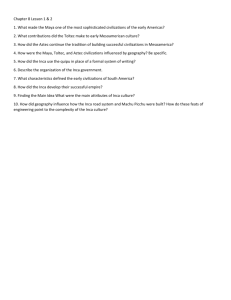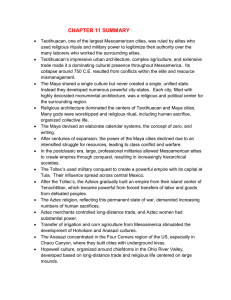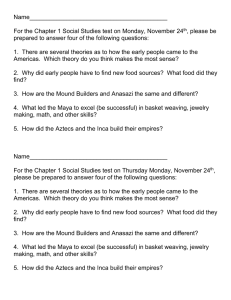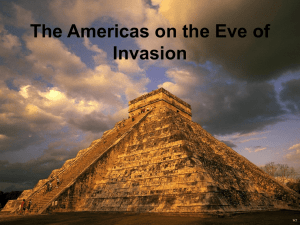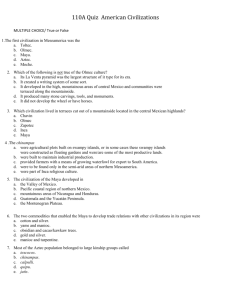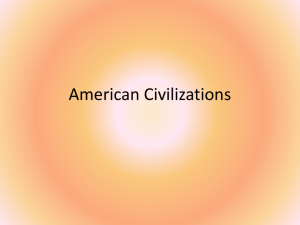The Americas on the Eve of Invasion Chapter 11
advertisement
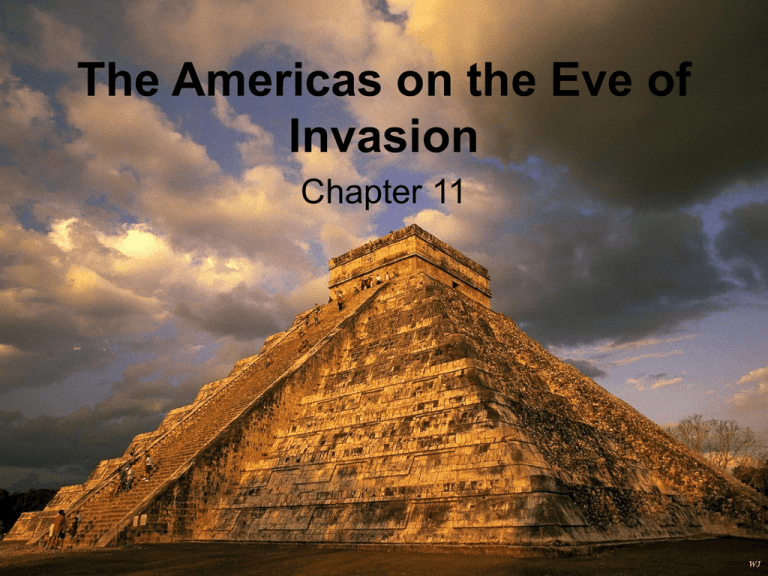
The Americas on the Eve of Invasion Chapter 11 Classical Era in the Americas approx. 600-900 • Indigenous peoples built upon the past – Similar religion & architecture • Created thriving civilizations – – – – – – Political organization Advanced math, astronomy Agricultural techniques Population growth and urbanization Social Stratification Developed economies & trade • Major Classical Civilizations – Teotihuacán (teh-o-tee-Wah-kahn) – Maya Teotihuacán – 30 miles northeast of modern-day Mexico City – Height of power in 600 – Largest city in Americas: 125,000-200,000 ppl • Urban population lived in apartment compounds – live in city & work on farms outside city – Government: • Most likely ruled by alliance of elite families & priests – Elites & priests distinguished themselves through diet, dress, residence – Religion: • Polytheistic: Quetzalcoatl most impt. God • Human sacrifice • Pyramid temples – Economy: • Agriculture and trade • Chinampas (floating gardens) • Military to protect trade – Collapse around 650 • Likely due to class struggles, mismanagement of resources, invasion Maya • Tropical Climate, poor soil • Variety of ag. techniques depending on environment – Slash & burn (aka swidden agriculture) – Drain swamps for land – terracing • Government: – Series of rival kingdoms w/ hereditary rulers • Rulers serve both political & religious function Maya Empire http://www.adishakti.org/images_foreign/mayamap_L.gif Maya • Religion – 3 layer cosmos (underworld, human world, heavens) – Close tie b/t warfare and religion • Rituals & fasting before war • Use of war to gain captives – Many used for human sacrifice; others for labor – Bloodletting, tattooing, painting of skin – Elaborately decorated temples • Symbolic of the cosmos • aligned w/ sun & planets • Science/Technology – Sophisticated calendar-making – Hieroglyphic writing system – Concept of zero in mathematics http://www.mnsu.edu/emuseum/prehistory/latin america/images/maya_hieroglyphs.gif Maya • Collapse of the Maya – Cities abandoned between 800 and 900 – No clear explanation – Possible reasons • Disease • Decline in trade (likely associated with fall of Teotihuacán) • Environmental degradation • Decline in agricultural production • Internal warfare Post-Classical Americas approx. 900-1500 • Continuity: – Many characteristics of the classical period continue • Architecture, religion, social structure, urban organization • Change: – Compared to earlier periods, the PostClassical period was characterized by • Increased agricultural production, population growth, increased warfare and conquest Toltecs • Created military state in Mexico and Central America – Capital: Tula • Influential on later Mesoamerican empires • Warlike culture – Temples and art depicts scenes of war and human sacrifice • Dual Kingship – Led to weakness and division • Power struggle and decline around 1000 • 1156: Tula invaded and Toltec culture overrun by other groups Toltec Warriors http://www.kidspast.com/images/toltecs.jpg Aztec Mexica (Meh-she-ca) • Moved into Central Mexico after decline of Toltecs – Originally, clans who served other more powerful groups • Began to buildup powerbase near Lake Texoco • 1325: construction on Tenochtitlan & Tlateloco – Twin capitals- Foundation of Mexico City • Began to expand & take new territory – Buildup of an empire Aztec http://www.plu.edu/~arnoldwp/img/aztec-empire.jpg Aztec • Government: – Single ruler chosen by council of aristocrats • Did not have absolute power – Ruler chosen from royal family, but not based upon primogeniture – Military conquest to display their power • Tie between war and religion Aztec • Social Structure: – Great degree of social & economic inequality • Power and land controlled by elites and warriors • Lower classes often worked as slaves or landless commoners on estates owned by elites – Little opportunity for social mobility • Highest positions in society were hereditary Aztec • Economy: – Relied upon ag. to feed urban population • Irrigation, dikes, chinampas to increase ag. – Tribute system supplied other goods to city • Conquered peoples sent food, cloth, luxury items, military equipment, and sacrificial victims to city – Trade important • Barter system Aztec • Religion: – Polytheistic – Most gods were both male and female – Temples dedicated to gods – Extensive use of human sacrifice • Thousands annually • Both religious and political function – Aztecs believed Huitzilopochtli required a steady supply of human hearts in order to bring the sun’s warmth to Earth – Public sacrifice helped deter rebellion and opposition Northern Peoples • By 900, organized societies had emerged in the American Southwest and Mississippi River Valley regions. – Much like the societies of Mesoamerica, these northern peoples depended upon maize, beans, and squash to help feed their populations. • Major societies: – Southwest: Anasazi – Mississippi Mound Builders Anasazi • “ancient ones” – Located in American Southwest – Large community in Chaco Canyon of NM • Influenced by Mesoamerica – Beans, maize, squash • Urban life centered in underground buildings (kivas) – Accomplished as basket-making, cloth-weaving, and pottery w/ geometric patterns – More on Anasazi on p. 280 http://www.ancestral.com/images/maps/anasazi.gif http://www.desertusa.com/mag07/jan/images12_ 07/cro02.jpg Mississippi Mound Builders • Initially hunter-gatherers who then adopt ag. – Population increase leads to growth of cities – Most settlements near rivers • Government: Chiefdom • Urban centers had a plaza surrounded by large earthen mounds – Height of culture at Cahokia – Mounds served as residence for chiefs, temples for religious ceremony, and burial sites for elites • Decline of Cahokia in 13th century, smaller settlements continue to thrive until the arrival of the Europeans Andean Civilizations • In South America, a series of cultures grew in a most unlikely place – Harsh environment • Mountains (Andes) • Desert along west coast (Atacama) • Rainforest to the east • Andean civilizations typically followed the same plan for organization of society and the economy Andean Civilizations • Society: – Territorial states ruled by hereditary aristocrats and kings – Clan-based societies • Clan known as Ayllu • Each Ayllu owned land communally • Households in the Ayllu tied together by system of reciprocal obligation to help each other Andean Civilization • Economy: – On a larger scale, each state was organized in a system known as mitá • System required each ayllu to contribute workers to perform various forms of labor – Each person assigned a task (based largely upon gender) • To help promote efficiency, each community tended to specialize in a certain type of work based upon the environment – Ie. Coastal areas produced fish • Colonies were also sent out to exploit resources in the area – Societies used various ag techniques to improve productivity in the harsh environment • Irrigation, terracing, growing frost-resistant crops, etc. – All goods produced in the mitá system were then brought together for exchange • Use of quipu to keep records – Series of knotted colored cords http://www.orquidea.net/peru_travel_center/inca_empire.jpg Inca • Among the Andean Civilizations, the Inca are the best known • The Inca began as a chiefdom that began to expand its power in the 1430’s – Developed an imperial state in the Andes Mountains of South America – By 1525, population of over 6 million • Capital: Cuzco (Peru) http://www.anntravelcorp.com/fotos/p000001_ cuzco%20anntravel.jpg Machu Picchu City constructed at height of Inca Empire Inca • Use of typical Andean social and economic organization – Mitá system • Buildup of military • Government: – Rulers began reign with military conquest to prove their power • Heirs of the rulers taken hostage to ensure cooperation Inca • Achievements of the Inca: – Skilled at stone work • Stone buildings constructed w/o mortar – Cuzco constructed to look like a Mountain Lion • Palaces and temples in the center of the city • Temple of the Sun – Interior lined w/ gold – Temple used for ritual, ceremony, and occasional human sacrifice – Ruler used temple & ceremony to justify his rule – Quipu: record keeping system – Build upon earlier developments • Astronomical observation conducted by priests Inca • Highly structured, government-regulated economy led to prosperity • Imperial system created inequality • Ie. Commoners could be executed for daring to look the ruler in the face • 1525: Stage is set for European conquest – Inca were weakened by internal division • Ruler died, triggering a power struggle between his two sons • Civil war weakens the Inca – Making them vulnerable to Europeans
